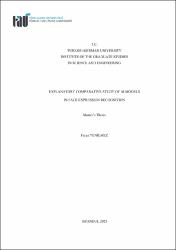| dc.contributor.author | Yenilmez, Fulya | |
| dc.date.accessioned | 2024-03-14T14:36:34Z | |
| dc.date.available | 2024-03-14T14:36:34Z | |
| dc.date.issued | 2023 | en_US |
| dc.date.submitted | 2023-07-21 | |
| dc.identifier.citation | Yenilmez, Fulya (2023). Explanatory comparative study of AI models in face expression recognition. Türk-Alman Üniversitesi, Fen Bilimleri Enstitüsü, İstanbul. | en_US |
| dc.identifier.uri | https://hdl.handle.net/20.500.12846/797 | |
| dc.description.abstract | This thesis provides an analysis and comparison of five widely used CNN architec tures in face expression recognition task. The objective is to evaluate the performance
of different CNN architectures available in the Keras library for this challenging com puter vision task. The chosen CNN architectures for comparison include VGG19,
InceptionV3, ResNet152V2, MobileNetV2, and EfficientNetV2B1. Two different
kinds of facial datasets are used in this research. The first dataset is Fer2013, a com monly used dataset in this domain known for its unbalanced structure. The second
dataset is the FACES dataset from the Max-Planck Institute, comprising posed im ages of individuals with a balanced structure. Both of these datasets contain labeled
face expression images. Pre-processing steps, such as rotation, shift, resizing, and
rescaling, are applied to these images. Since this is a comparative analysis study, the
same transfer learning steps are applied to all models. The results from this training
are evaluated using test accuracy, which is necessary for analyzing every aspect of the
study. To ensure a fair comparison, the same transfer learning steps are applied to all
models. The models are trained by dividing the dataset into three sets; training data
set, validation data set, and test data set.
The comparative study reveals that each CNN architecture exhibits different levels
of performance in facial expression recognition tasks. The study provides significant
knowledge about the strengths and weaknesses of each CNN architecture in face ex pression recognition.
Overall, this comparison study provides clarity on the effectiveness of VGG19, In ceptionV3, ResNet152V2, MobileNetv2, and EfficientNetV2B1 architectures in rec ognizing facial expressions. It serves as a valuable resource for researchers in the
fields of computer vision and expression analysis | en_US |
| dc.description.abstract | Bu tez, yüz ifadesi tanıma görevinde yaygın olarak kullanılan be¸s CNN mimarisinin
analizini ve kar¸sıla¸stırmasını sunmaktadır. Amaç, bu zorlu bilgisayarla görme görevi
için Keras kütüphanesinde bulunan farklı CNN mimarilerinin performansını deger- ˘
lendirmektir. Kar¸sıla¸stırma için seçilen CNN mimarileri arasında VGG19, Incepti onV3, ResNet152V2, MobileNetV2 ve EfficientNetV2B1 bulunmaktadır.
Bu ara¸stırmada iki farklı türde yüz veri seti kullanılmı¸stır. ˙Ilk veri seti, dengesiz ya pısıyla bilinen ve bu alanda yaygın olarak kullanılan Fer2013 veri setidir. ˙Ikinci veri
seti ise Max-Planck Enstitüsü’nün FACES veri setidir ve dengeli bir yapıya sahip
bireylerin pozlanmı¸s görüntülerinden olu¸smaktadır. Bu veri setlerinin her ikisi de eti ketli yüz ifadesi içeren görüntülerdir. Bu görüntülere döndürme, kaydırma, yeniden
boyutlandırma ve yeniden ölçeklendirme gibi ön i¸sleme adımları uygulanmı¸stır. Bu
bir kar¸sıla¸stırmalı analiz çalı¸sması oldugu için tüm modellere aynı transfer ö ˘ grenme ˘
adımları uygulanır. Bu egitimden elde edilen sonuçlar, çalı¸smanın her yönünü ana- ˘
liz etmek için gerekli olan test dogrulu ˘ gu kullanılarak de ˘ gerlendirilir. Adil bir kar¸sı- ˘
la¸stırma saglamak için tüm modellere aynı transfer ö ˘ grenme adımları uygulanmı¸stır. ˘
Modeller, veri seti üç kümeye bölünerek egitilir; e ˘ gitim veri seti, do ˘ grulama veri seti ˘
ve test veri seti.
Kar¸sıla¸stırmalı çalı¸sma, her CNN mimarisinin yüz ifadesi tanıma görevlerinde farklı
performans seviyeleri sergiledigini ortaya koymaktadır. Çalı¸sma, yüz ifadesi tanımada her bir CNN mimarisinin güçlü ve zayıf yönleri hakkında önemli bilgiler sag-˘
lamaktadır.
Genel olarak, bu kar¸sıla¸stırma çalı¸sması VGG19, InceptionV3, ResNet152V2, Mobi leNetv2 ve EfficientNetV2B1 mimarilerinin yüz ifadelerini tanımadaki etkinligi hak- ˘
kında netlik saglamaktadır. Bilgisayarla görme ve ifade analizi alanlarındaki ara¸stır- ˘
macılar için degerli bir kaynak niteli ˘ gindedir | en_US |
| dc.language.iso | eng | en_US |
| dc.publisher | Türk-Alman Üniversitesi Fen Bilimler Enstitüsü | en_US |
| dc.rights | info:eu-repo/semantics/openAccess | en_US |
| dc.subject | Face expression recognition | en_US |
| dc.subject | Neural networks | en_US |
| dc.subject | CNN architectures | en_US |
| dc.subject | Transfer learning | en_US |
| dc.subject | Fine-tuning | en_US |
| dc.subject | Yüz ifadesi tanıma | en_US |
| dc.subject | Sinir ağları | en_US |
| dc.subject | CNN mimarileri | en_US |
| dc.subject | Öğrenme aktarımı | en_US |
| dc.subject | İnce ayarlama | en_US |
| dc.title | Explanatory comparative study of AI models in face expression recognition | en_US |
| dc.title.alternative | Yüz ifadesi tanıma alanında yapay zeka modellerinin karşılaştırılmalı açıklamalı çalışması | en_US |
| dc.type | masterThesis | en_US |
| dc.relation.publicationcategory | Tez | en_US |
| dc.contributor.department | TAÜ, Fen Bilimleri Enstitüsü, Robotlar ve Akıllı Sistemler Ana Bilim Dalı Koleksiyonu | en_US |

















